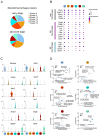Single-Nuclei Transcriptome Profiling Reveals Intra-Tumoral Heterogeneity and Characterizes Tumor Microenvironment Architecture in a Murine Melanoma Model
- PMID: 39457009
- PMCID: PMC11508838
- DOI: 10.3390/ijms252011228
Single-Nuclei Transcriptome Profiling Reveals Intra-Tumoral Heterogeneity and Characterizes Tumor Microenvironment Architecture in a Murine Melanoma Model
Abstract
Malignant melanoma is an aggressive cancer, with a high risk of metastasis and mortality rates, characterized by cancer cell heterogeneity and complex tumor microenvironment (TME). Single cell biology is an ideal and powerful tool to address these features at a molecular level. However, this approach requires enzymatic cell dissociation that can influence cellular coverage. By contrast, single nucleus RNA sequencing (snRNA-seq) has substantial advantages including compatibility with frozen samples and the elimination of a dissociation-induced, transcriptional stress response. To better profile and understand the functional diversity of different cellular components in melanoma progression, we performed snRNA-seq of 16,839 nuclei obtained from tumor samples along the growth of murine syngeneic melanoma model carrying a BRAFV600E mutation and collected 9 days or 23 days after subcutaneous cell injection. We defined 11 different subtypes of functional cell clusters among malignant cells and 5 different subsets of myeloid cells that display distinct global transcriptional program and different enrichment in early or advanced stage of tumor growth, confirming that this approach was useful to accurately identify intratumor heterogeneity and dynamics during tumor evolution. The current study offers a deep insight into the biology of melanoma highlighting TME reprogramming through tumor initiation and progression, underlying further discovery of new TME biomarkers which may be potentially druggable.
Keywords: heterogeneity; melanoma; single-nuclei sequencing; transcriptome; tumor microenvironment.
Conflict of interest statement
The authors declare no conflicts of interest.
Figures








References
-
- Wolchok J.D., Chiarion-Sileni V., Gonzalez R., Grob J.-J., Rutkowski P., Lao C.D., Cowey C.L., Schadendorf D., Wagstaff J., Dummer R., et al. Long-Term Outcomes With Nivolumab Plus Ipilimumab or Nivolumab Alone Versus Ipilimumab in Patients With Advanced Melanoma. J. Clin. Oncol. 2022;40:127–137. doi: 10.1200/JCO.21.02229. - DOI - PMC - PubMed
-
- Robert C., Grob J.J., Stroyakovskiy D., Karaszewska B., Hauschild A., Levchenko E., Chiarion Sileni V., Schachter J., Garbe C., Bondarenko I., et al. Five-Year Outcomes with Dabrafenib plus Trametinib in Metastatic Melanoma. N. Engl. J. Med. 2019;381:626–636. doi: 10.1056/NEJMoa1904059. - DOI - PubMed
-
- Ascierto P.A., Dréno B., Larkin J., Ribas A., Liszkay G., Maio M., Mandalà M., Demidov L., Stroyakovskiy D., Thomas L., et al. 5-Year Outcomes with Cobimetinib plus Vemurafenib in BRAFV600 Mutation-Positive Advanced Melanoma: Extended Follow-up of the coBRIM Study. Clin. Cancer Res. Off. J. Am. Assoc. Cancer Res. 2021;27:5225–5235. doi: 10.1158/1078-0432.CCR-21-0809. - DOI - PMC - PubMed
-
- Dummer R., Flaherty K.T., Robert C., Arance A., de Groot J.W.B., Garbe C., Gogas H.J., Gutzmer R., Krajsová I., Liszkay G., et al. COLUMBUS 5-Year Update: A Randomized, Open-Label, Phase III Trial of Encorafenib Plus Binimetinib Versus Vemurafenib or Encorafenib in Patients With BRAF V600–Mutant Melanoma. J. Clin. Oncol. 2022;40:4178–4188. doi: 10.1200/JCO.21.02659. - DOI - PMC - PubMed
MeSH terms
Substances
Grants and funding
LinkOut - more resources
Full Text Sources
Medical

